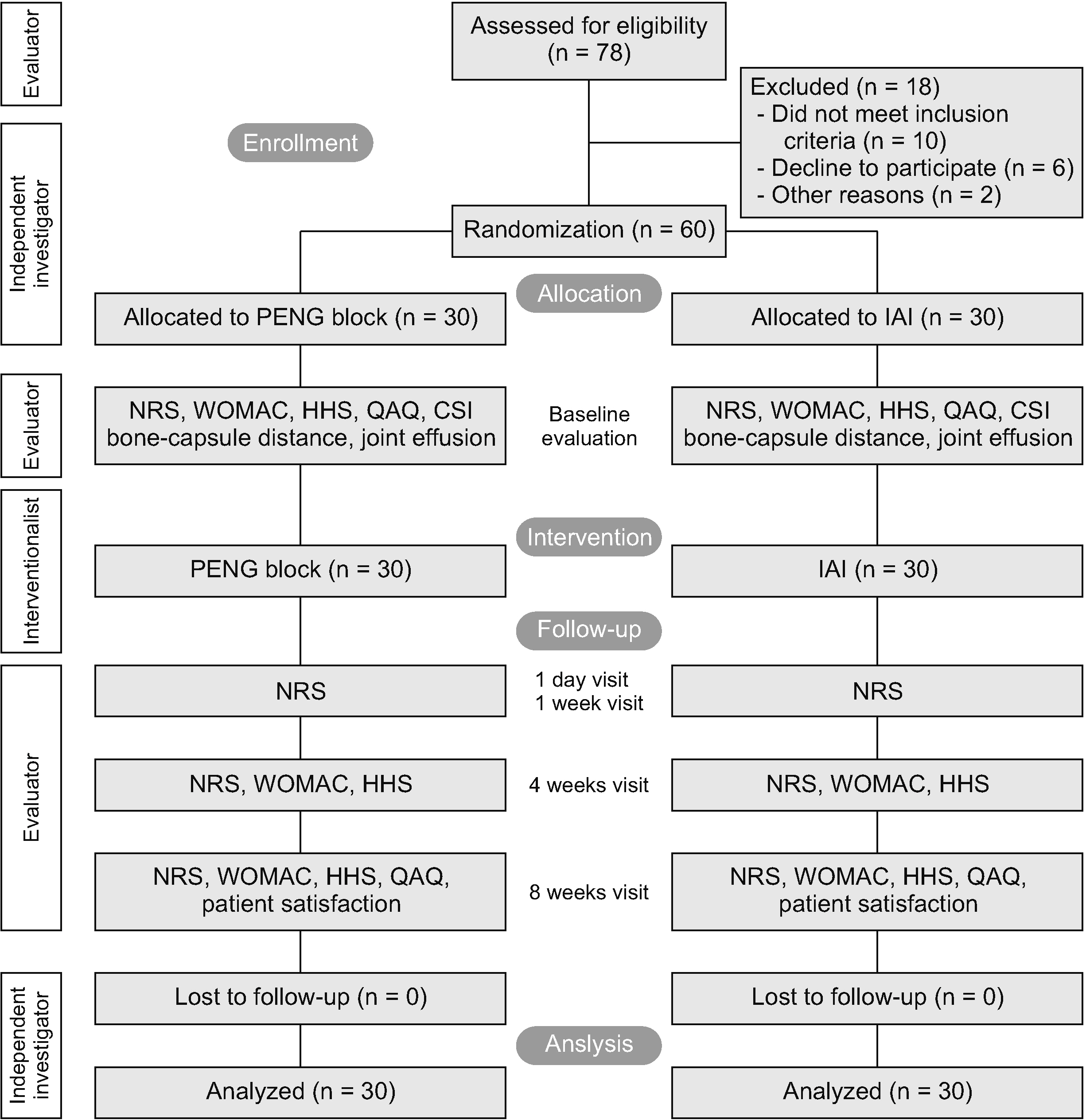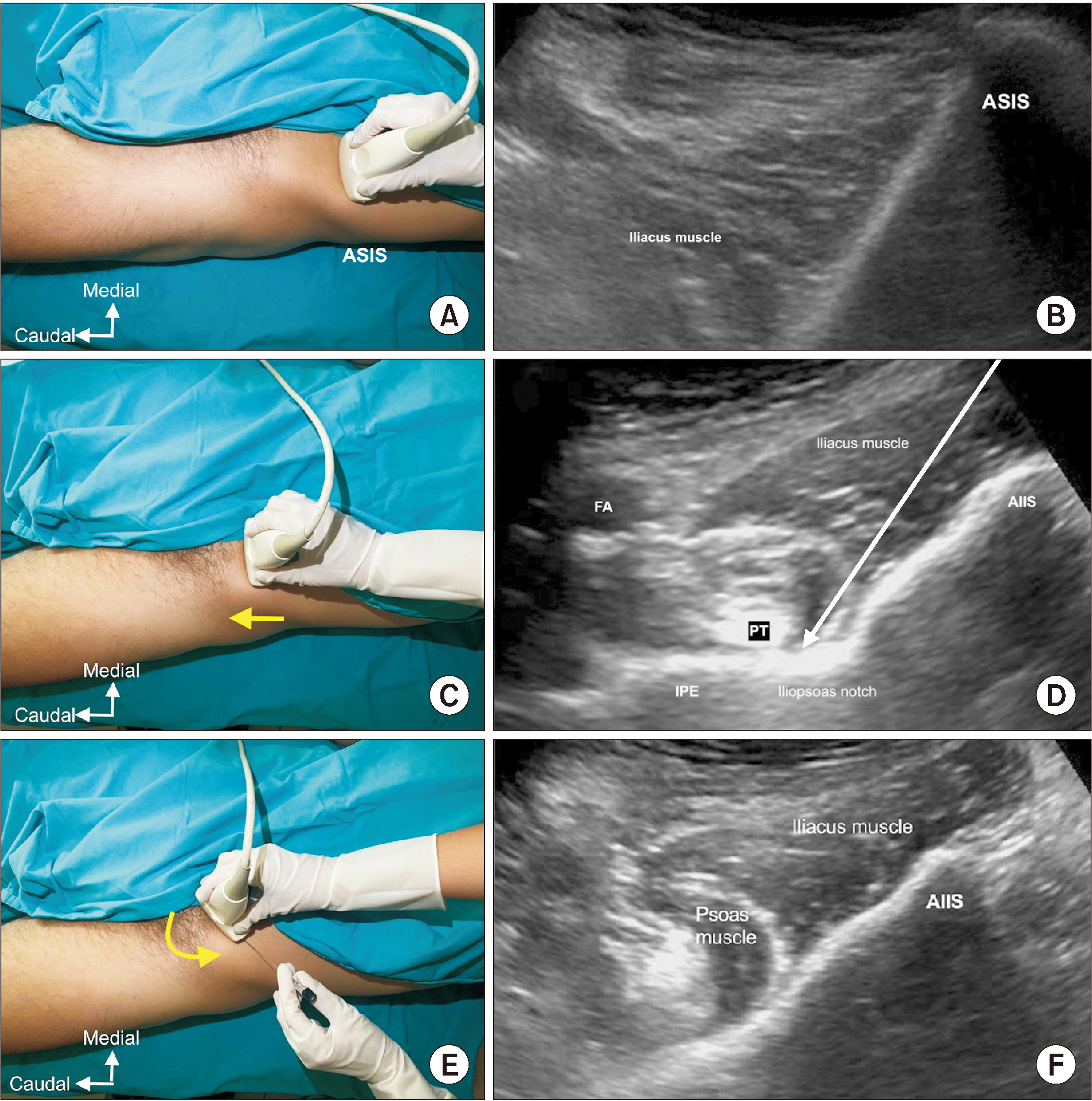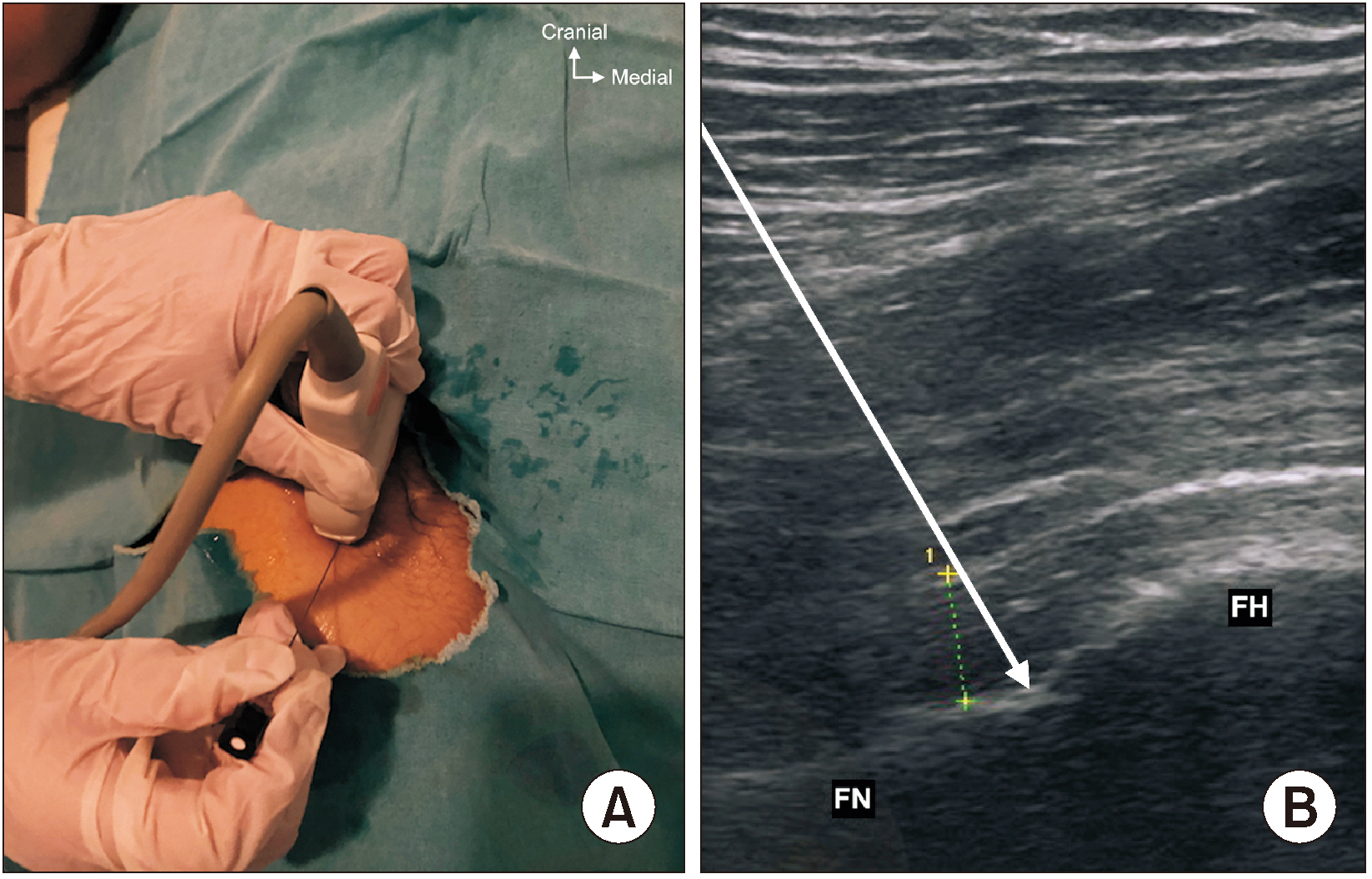Korean J Pain.
2023 Apr;36(2):195-207. 10.3344/kjp.22325.
Ultrasound-guided PENG block versus intraarticular corticosteroid injection in hip osteoarthritis: a randomised controlled study
- Affiliations
-
- 1Department of Pain Medicine, Health Science University Gaziler Physical Therapy and Rehabilitation Training and Research Hospital, Ankara, Turkiye
- 2Department of Pain Medicine, Health Science University Diskapi Yildirim Beyazit Training and Research Hospital, Ankara, Turkiye
- 3Department of Physical Therapy and Rehabilitation, Sakarya Training and Research Hospital, Sakarya, Turkiye
- 4Department of Anesthesiology and Reanimation, Samsun University Faculty of Medicine, Samsun Training and Research Hospital, Samsun, Turkiye
- KMID: 2541028
- DOI: http://doi.org/10.3344/kjp.22325
Abstract
- Background
This study aimed to compare the effectiveness of the pericapsular nerve group (PENG) block and intra-articular injection (IAI) of steroid-bupivacaine in the treatment of hip osteoarthritis (OA).
Methods
After randomization, patients received either a PENG block or IAI under ultrasound-guidance. Clinical evaluations were recorded at baseline, day 1, and weeks 1, 4, and 8 post-intervention. The numerical rating scale (NRS), Western Ontario and McMaster Universities Arthritis Index (WOMAC), Harris Hip Scale (HHS) scores, pain medication use determined by a quantitative analgesic questionnaire, and patient satisfaction were evaluated.
Results
Sixty patients were included in this study. NRS scores improved significantly for both groups during the follow-up compared to pretreatment (P < 0.001), with better pain scores for the PENG group (P < 0.001) at day 1 with larger effect size (Cohen’s d = 4.62), and IAI group at 4 (Cohen’s d = 5.15) and 8 (Cohen’s d = 4.33) weeks (P < 0.001). There was no significant difference in pain medication consumption (P = 0.499) and patient satisfaction (P = 0.138) between groups. Patients in the IAI group experienced significant improvement in HHS (Cohen’s d = 2.16, P = 0.007) and WOMAC (Cohen’s d = 1.02, P = 0.036) scores at 8 weeks compared to the PENG group.
Conclusions
The ultrasound-guided PENG block provides effective pain relief which improves functionality and quality of life in hip OA patients up to 2 months. The PENG block can be considered an easy, safe, and useful alternative treatment modality for hip OA.
Keyword
Figure
Reference
-
1. Brandt KD, Radin EL, Dieppe PA, van de Putte L. 2006; Yet more evidence that osteoarthritis is not a cartilage disease. Ann Rheum Dis. 65:1261–4. DOI: 10.1136/ard.2006.058347. PMID: 16973787. PMCID: PMC1798332.2. GBD 2015 Disease and Injury Incidence and Prevalence Collaborators. 2016; Global, regional, and national incidence, prevalence, and years lived with disability for 310 diseases and injuries, 1990-2015: a systematic analysis for the Global Burden of Disease Study 2015. Lancet. 388:1545–602. Erratum in: Lancet 2017; 389: e1. DOI: 10.1016/S0140-6736(16)31678-6. PMID: 27733282. PMCID: PMC5055577.3. Murphy LB, Helmick CG, Schwartz TA, Renner JB, Tudor G, Koch GG, et al. 2010; One in four people may develop symptomatic hip osteoarthritis in his or her lifetime. Osteoarthritis Cartilage. 18:1372–9. DOI: 10.1016/j.joca.2010.08.005. PMID: 20713163. PMCID: PMC2998063.4. Hiligsmann M, Cooper C, Arden N, Boers M, Branco JC, Luisa Brandi M, et al. 2013; Health economics in the field of osteoarthritis: an expert's consensus paper from the European Society for Clinical and Economic Aspects of Osteoporosis and Osteoarthritis (ESCEO). Semin Arthritis Rheum. 43:303–13. DOI: 10.1016/j.semarthrit.2013.07.003. PMID: 23992801.5. Nelson AE, Allen KD, Golightly YM, Goode AP, Jordan JM. 2014; A systematic review of recommendations and guidelines for the management of osteoarthritis: the chronic osteoarthritis management initiative of the U.S. bone and joint initiative. Semin Arthritis Rheum. 43:701–12. DOI: 10.1016/j.semarthrit.2013.11.012. PMID: 24387819.6. Dowsey MM, Nikpour M, Dieppe P, Choong PF. 2012; Associations between pre-operative radiographic changes and outcomes after total knee joint replacement for osteoarthritis. Osteoarthritis Cartilage. 20:1095–102. DOI: 10.1016/j.joca.2012.05.015. PMID: 22800770.7. Liu SS, Buvanendran A, Rathmell JP, Sawhney M, Bae JJ, Moric M, et al. 2012; A cross-sectional survey on prevalence and risk factors for persistent postsurgical pain 1 year after total hip and knee replacement. Reg Anesth Pain Med. 37:415–22. DOI: 10.1097/AAP.0b013e318251b688. PMID: 22660483.8. Choueiri M, Chevalier X, Eymard F. 2021; Intraarticular corticosteroids for hip osteoarthritis: a review. Cartilage. 13(1_suppl):122S–31S. DOI: 10.1177/1947603520951634. PMID: 32815375. PMCID: PMC8808783.9. Bannuru RR, Osani MC, Vaysbrot EE, Arden NK, Bennell K, Bierma-Zeinstra SMA, et al. 2019; OARSI guidelines for the non-surgical management of knee, hip, and polyarticular osteoarthritis. Osteoarthritis Cartilage. 27:1578–89. DOI: 10.1016/j.joca.2019.06.011. PMID: 31278997.10. Kolasinski SL, Neogi T, Hochberg MC, Oatis C, Guyatt G, Block J, et al. 2020; 2019 American College of Rheumatology/Arthritis Foundation guideline for the management of osteoarthritis of the hand, hip, and knee. Arthritis Care Res (Hoboken). 72:149–62. Erratum in: Arthritis Care Res (Hoboken) 2021; 73: 764. DOI: 10.1002/acr.24131. PMID: 31908149.11. Kompel AJ, Roemer FW, Murakami AM, Diaz LE, Crema MD, Guermazi A. 2019; Intra-articular corticosteroid injections in the hip and knee: perhaps not as safe as we thought? Radiology. 293:656–63. DOI: 10.1148/radiol.2019190341. PMID: 31617798.12. Ming LH, Chin CS, Yang CT, Suhaimi A. 2022; Adductor canal block versus intra-articular steroid and lidocaine injection for knee osteoarthritis: a randomized controlled study. Korean J Pain. 35:191–201. DOI: 10.3344/kjp.2022.35.2.191. PMID: 35354682. PMCID: PMC8977207.13. Ghai B, Kumar M, Makkar JK, Goni V. 2022; Comparison of ultrasound guided pulsed radiofrequency of genicular nerve with local anesthetic and steroid block for management of osteoarthritis knee pain. Korean J Pain. 35:183–90. DOI: 10.3344/kjp.2022.35.2.183. PMID: 35354681. PMCID: PMC8977196.14. Yavuz F, Yasar E, Ali Taskaynatan M, Goktepe AS, Tan AK. 2013; Nerve block of articular branches of the obturator and femoral nerves for the treatment of hip joint pain. J Back Musculoskelet Rehabil. 26:79–83. DOI: 10.3233/BMR-2012-00353. PMID: 23411652.15. Girón-Arango L, Peng PW, Chin KJ, Brull R, Perlas A. 2018; Pericapsular nerve group (PENG) block for hip fracture. Reg Anesth Pain Med. 43:859–63. DOI: 10.1097/AAP.0000000000000847. PMID: 30063657.16. Rocha Romero A, Carvajal Valdy G, Lemus AJ. 2019; Ultrasound-guided pericapsular nerve group (PENG) hip joint phenol neurolysis for palliative pain. Can J Anaesth. 66:1270–1. DOI: 10.1007/s12630-019-01448-y. PMID: 31301017.17. Pimenta MV, Nakamura AT, Ashmawi HA, Vieira JE, Dos San H. 2021; Ultrasound-guided pericapsular nerve group and obturator nerve phenol neurolysis for refractory inpatient hip cancer metastasis pain: a case report. Braz J Anesthesiol. doi: 10.1016/j.bjane.2021.02.037. DOI: 10.1016/j.bjane.2021.02.037. PMID: 33766686.18. Altman R, Alarcón G, Appelrouth D, Bloch D, Borenstein D, Brandt K, et al. 1991; The American College of Rheumatology criteria for the classification and reporting of osteoarthritis of the hip. Arthritis Rheum. 34:505–14. DOI: 10.1002/art.1780340502. PMID: 2025304.19. Koski JM, Anttila PJ, Isomäki HA. 1989; Ultrasonography of the adult hip joint. Scand J Rheumatol. 18:113–7. DOI: 10.3109/03009748909099926. PMID: 2660254.20. Qvistgaard E, Torp-Pedersen S, Christensen R, Bliddal H. 2006; Reproducibility and inter-reader agreement of a scoring system for ultrasound evaluation of hip osteoarthritis. Ann Rheum Dis. 65:1613–9. DOI: 10.1136/ard.2005.050690. PMID: 16728462. PMCID: PMC1798465.21. Bellamy N, Buchanan WW, Goldsmith CH, Campbell J, Stitt LW. 1988; Validation study of WOMAC: a health status instrument for measuring clinically important patient relevant outcomes to antirheumatic drug therapy in patients with osteoarthritis of the hip or knee. J Rheumatol. 15:1833–40. PMID: 3068365.22. Mahomed NN, Arndt DC, McGrory BJ, Harris WH. 2001; The Harris hip score: comparison of patient self-report with surgeon assessment. J Arthroplasty. 16:575–80. DOI: 10.1054/arth.2001.23716. PMID: 11503116.23. Robinson-Papp J, George MC, Wongmek A, Nmashie A, Merlin JS, Ali Y, et al. 2015; The quantitative analgesic questionnaire: a tool to capture patient-reported chronic pain medication use. J Pain Symptom Manage. 50:381–6. DOI: 10.1016/j.jpainsymman.2015.03.013. PMID: 25912277. PMCID: PMC4550505.24. Neblett R, Cohen H, Choi Y, Hartzell MM, Williams M, Mayer TG, et al. 2013; The Central Sensitization Inventory (CSI): establishing clinically significant values for identifying central sensitivity syndromes in an outpatient chronic pain sample. J Pain. 14:438–45. DOI: 10.1016/j.jpain.2012.11.012. PMID: 23490634. PMCID: PMC3644381.25. Preedy VR, Watson RR, editors. 2010. 5-point Likert scale. Handbook of disease burdens and quality of life measures. Springer;p. 4288. DOI: 10.1007/978-0-387-78665-0_6363.26. Atchia I, Kane D, Reed MR, Isaacs JD, Birrell F. 2011; Efficacy of a single ultrasound-guided injection for the treatment of hip osteoarthritis. Ann Rheum Dis. 70:110–6. DOI: 10.1136/ard.2009.127183. PMID: 21068096.27. Hunter DJ, Bierma-Zeinstra S. 2019; Osteoarthritis. Lancet. 393:1745–59. DOI: 10.1016/S0140-6736(19)30417-9. PMID: 31034380.28. Healy WL, Iorio R, Clair AJ, Pellegrini VD, Della Valle CJ, Berend KR. 2016; Complications of total hip arthroplasty: standardized list, definitions, and stratification developed by The Hip Society. Clin Orthop Relat Res. 474:357–64. DOI: 10.1007/s11999-015-4341-7. PMID: 26040966. PMCID: PMC4709292.29. Hwang SK. 2014; Experience of complications of hip arthroplasty. Hip Pelvis. 26:207–13. DOI: 10.5371/hp.2014.26.4.207. PMID: 27536583. PMCID: PMC4971395.30. Gundel O, Thygesen LC, Gögenur I, Ekeloef S. 2020; Postoperative mortality after a hip fracture over a 15-year period in Denmark: a national register study. Acta Orthop. 91:58–62. DOI: 10.1080/17453674.2019.1680485. PMID: 31635502. PMCID: PMC7006693. PMID: 38564c83067047f1babff86a1027056f.31. Yanagidate F, Strichartz GR. 2007; Local anesthetics. Handb Exp Pharmacol. (177):95–127. DOI: 10.1007/978-3-540-33823-9_4. PMID: 17087121.32. Salerno A, Hermann R. 2006; Efficacy and safety of steroid use for postoperative pain relief. Update and review of the medical literature. J Bone Joint Surg Am. 88:1361–72. DOI: 10.2106/00004623-200606000-00029. PMID: 16757774.33. Conrozier T, Patarin J, Mathieu P, Rinaudo M. 2016; Steroids, lidocain and ioxaglic acid modify the viscosity of hyaluronic acid: in vitro study and clinical implications. Springerplus. 5:170. DOI: 10.1186/s40064-016-1762-z. PMID: 27026867. PMCID: PMC4766165.34. Yamak Altinpulluk E, Galluccio F, Salazar C, Espinoza K, Olea MS, Hochberg U, et al. 2020; Peng block in prosthetic hip replacement: a cadaveric radiological evaluation. J Clin Anesth. 65:109888. DOI: 10.1016/j.jclinane.2020.109888. PMID: 32447169.35. Tran J, Agur A, Peng P. 2019; Is pericapsular nerve group (PENG) block a true pericapsular block? Reg Anesth Pain Med. 44:257. DOI: 10.1136/rapm-2018-100278. PMID: 30635511.36. Jadon A. 2021; Pulsed radiofrequency (PRF) of pericapsular nerves group (PENG) in chronic hip pain-a case report. Turk J Anaesthesiol Reanim. 49:490–3. DOI: 10.5152/TJAR.2021.1080. PMID: 35110031. PMCID: PMC9472694.37. Fusco P, Petroni GM, DI Carlo S, Maggiani C, Marinangeli F, Ciaschi W. 2021; PENG radiofrequency and hip chronic pain: is this the future? Minerva Anestesiol. 87:1391–3. DOI: 10.23736/S0375-9393.21.15929-2. PMID: 34337925.38. McCabe PS, Maricar N, Parkes MJ, Felson DT, O'Neill TW. 2016; The efficacy of intra-articular steroids in hip osteoarthritis: a systematic review. Osteoarthritis Cartilage. 24:1509–17. DOI: 10.1016/j.joca.2016.04.018. PMID: 27143362.39. Zhong HM, Zhao GF, Lin T, Zhang XX, Li XY, Lin JF, et al. 2020; Intra-articular steroid injection for patients with hip osteoarthritis: a systematic review and meta-analysis. Biomed Res Int. 2020:6320154. DOI: 10.1155/2020/6320154. PMID: 32185212. PMCID: PMC7060863.40. Peters RH, Rasker JJ, Jacobs JW, Prevo RL, Karthaus RP. 1992; Bacterial arthritis in a district hospital. Clin Rheumatol. 11:351–5. DOI: 10.1007/BF02207192. PMID: 1458782.41. Kaandorp CJ, van Schaardenburg D, Krijnen P. 1999; Antibiotic prophylaxis of hematogenous bacterial arthritis. Ned Tijdschr Geneeskd. 143:1808–11. Dutch. PMID: 10526583.42. Papavasiliou AV, Isaac DL, Marimuthu R, Skyrme A, Armitage A. 2006; Infection in knee replacements after previous injection of intra-articular steroid. J Bone Joint Surg Br. 88:321–3. DOI: 10.1302/0301-620X.88B3.17136. PMID: 16498004.43. Cancienne JM, Werner BC, Luetkemeyer LM, Browne JA. 2015; Does timing of previous intra-articular steroid injection affect the post-operative rate of infection in total knee arthroplasty? J Arthroplasty. 30:1879–82. DOI: 10.1016/j.arth.2015.05.027. PMID: 26071248.44. eekumar R Sr, Venkiteswaran R, Raut V. 2007; Infection in primary hip arthroplasty after previous steroid infiltration. Int Orthop. 31:125–8. DOI: 10.1007/s00264-006-0152-5. PMID: 16804732. PMCID: PMC2267548.45. Desai A, Ramankutty S, Board T, Raut V. 2009; Does intraarticular steroid infiltration increase the rate of infection in subsequent total knee replacements? Knee. 16:262–4. DOI: 10.1016/j.knee.2008.12.002. PMID: 19138855.46. Del Buono R, Padua E, Pascarella G, Costa F, Tognù A, Terranova G, et al. 2021; Pericapsular nerve group block: an overview. Minerva Anestesiol. 87:458–66. DOI: 10.23736/S0375-9393.20.14798-9. PMID: 33432791.47. Alakkad H, Naeeni A, Chan VW, Abbas S, Oh J, Ami N, et al. 2015; Infection related to ultrasound-guided single-injection peripheral nerve blockade: a decade of experience at toronto Western hospital. Reg Anesth Pain Med. 40:82–4. DOI: 10.1097/AAP.0000000000000181. PMID: 25469758.48. Park KD, Kim TK, Bae BW, Ahn J, Lee WY, Park Y. 2015; Ultrasound guided intra-articular ketorolac versus corticosteroid injection in osteoarthritis of the hip: a retrospective comparative study. Skeletal Radiol. 44:1333–40. DOI: 10.1007/s00256-015-2174-9. PMID: 26031217.49. Ladd LM, Keene JS, Del Rio AM, Rosas HG. 2016; Correlation between hip arthroscopy outcomes and preoperative anesthetic hip joint injections, MR arthrogram imaging findings, and patient demographic characteristics. AJR Am J Roentgenol. 207:1062–9. DOI: 10.2214/AJR.16.16383. PMID: 27533286.50. Alpaugh K, Logan C, Upadhyaya S, Martin SD. 2016; Intra-articular anesthetic injection of the hip for confirmation of symptomatic tears of the acetabular labrum: a systematic review. Orthop J Harv Med Sch. 17:30–8.
- Full Text Links
- Actions
-
Cited
- CITED
-
- Close
- Share
- Similar articles
-
- Feasibility of Ultrasound-Guided Intraarticular Contrast Injection for MR Arthrography
- Obturator Nerve Block Using Ultrasound-guided Intraneural Alcohol Injection in Patient with Hip Adductor Spasticity
- Comparing the effectiveness of ultrasound guided versus blind genicular nerve block on pain, muscle strength with isokinetic device, physical function and quality of life in chronic knee osteoarthritis: a prospective randomized controlled study
- Local Reactions after Intraarticular Hyaluronic Acid Injection for Osteoarthritis of the Knee
- The Analgesic Effect of Intraarticular Morphine in Osteoarthritis of Knee







